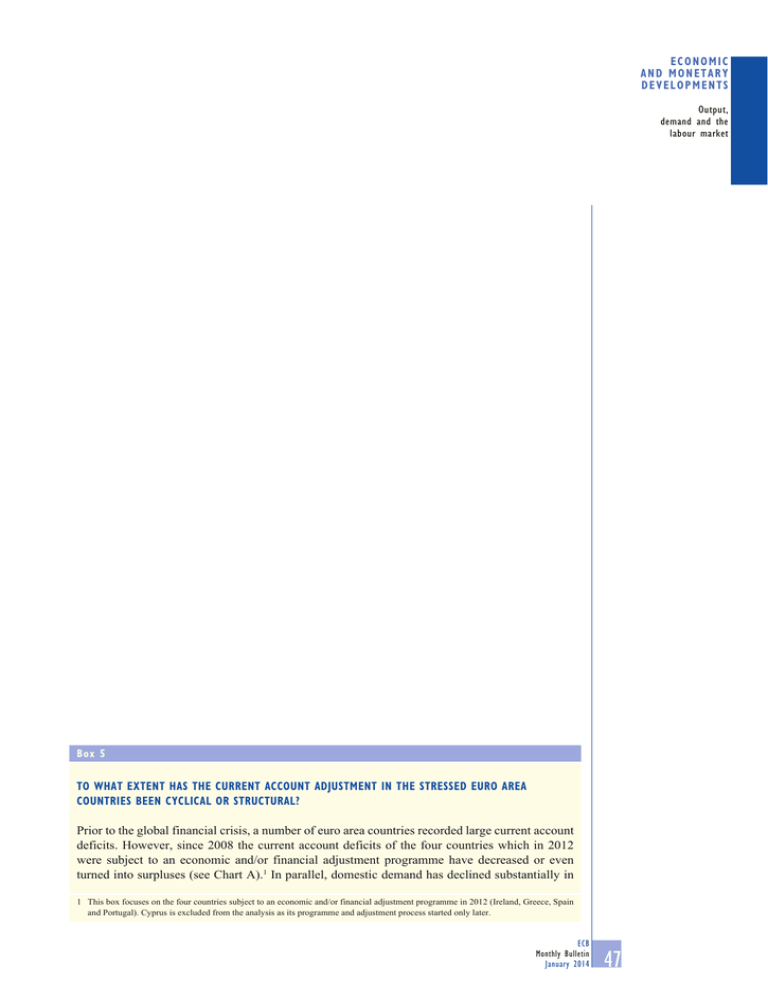To what extent has the current account adjustment in the stressed
advertisement

ECONOMIC AND MONETARY DEVELOPMENTS Output, demand and the labour market Box 5 TO WHAT EXTENT HAS THE CURRENT ACCOUNT ADJUSTMENT IN THE STRESSED EURO AREA COUNTRIES BEEN CYCLICAL OR STRUCTURAL? Prior to the global financial crisis, a number of euro area countries recorded large current account deficits. However, since 2008 the current account deficits of the four countries which in 2012 were subject to an economic and/or financial adjustment programme have decreased or even turned into surpluses (see Chart A).1 In parallel, domestic demand has declined substantially in 1 This box focuses on the four countries subject to an economic and/or financial adjustment programme in 2012 (Ireland, Greece, Spain and Portugal). Cyprus is excluded from the analysis as its programme and adjustment process started only later. ECB Monthly Bulletin January 2014 47 Chart A Current account balances Chart B Contributions to the change in trade balances between 2008 and 2012 (as a percentage of GDP) (percentage points of GDP) 2008 2012 contribution of imports contribution of exports change in the trade balance change in the current account balance 6 6 30 30 4 4 25 25 2 2 20 20 0 0 -2 -2 15 15 -4 -4 10 10 -6 -6 5 5 -8 -8 0 0 -10 -10 -12 -12 -5 -5 -14 -14 -10 -10 -16 -15 -16 Ireland Greece Spain Portugal Sources: Eurostat and national statistical institutes. -15 Ireland Greece Spain Portugal Sources: Eurostat and national statistical institutes. these countries. This raises the question of the extent to which the external adjustment has been driven by a cyclical compression of domestic demand, which might be reversed at some point, and the extent to which the adjustment is more structural in nature. A current account deficit can be reduced through a reduction in imports and/or an expansion of exports. During the ongoing adjustment of external imbalances in the stressed euro area countries both channels have played a role, albeit to varying degrees (see Chart B). In Spain and Portugal, the larger part of the improvement in current account balances is attributable to an increase in exports relative to GDP, while in Greece the improvement is mostly attributable to a compression of imports. In Ireland, exports have increased strongly since 2008, with imports contracting only in the initial stages of the adjustment phase and exceeding their pre-crisis level in 2012. The adjustment in exports and imports, in turn, typically reflects a decline in domestic demand relative to foreign demand or a depreciation of the real effective exchange rate of the country concerned. In the four stressed euro area countries under review, a combination of both mechanisms has been at work (see Chart C). While most of the contraction in relative demand occurred in the initial stages of the adjustment, the adjustment of relative prices, i.e. a real depreciation as measured by the harmonised competitiveness indicators deflated by unit labour costs, occurred only later and was most pronounced in 2012 (with the exception of Ireland). However, the adjustment in unit labour costs partly reflects productivity increases due to labour shedding rather than nominal wage adjustment. Moreover, the pass-through from unit labour costs to product prices has been incomplete. 48 ECB Monthly Bulletin January 2014 ECONOMIC AND MONETARY DEVELOPMENTS Output, demand and the labour market The decline in domestic demand relative to foreign demand appears to have been both cyclical and structural in nature. Between 2008 and 2012 the stressed countries recorded declines in real GDP of around 5% in the cases of Ireland, Spain and Portugal and 20% in the case of Greece. According to estimates by the IMF, the European Commission and the OECD, this only partly reflected a substantial widening of the output gap. For instance, for Greece the output gap is estimated to have widened by between 14 and 19 percentage points. However, potential output in Greece is estimated to have declined by up to 6% between 2008 and 2012. Also in the other stressed countries potential growth was either negative or fell short of world potential output growth of about 15%. This implies that a significant part of the decline in domestic demand of the stressed euro area countries relative to foreign demand is due to a decline in their potential output relative to that of the rest of the world. Chart C Relative demand and harmonised competitiveness indicators (index: 2009 = 100) x-axis: relative demand 1) y-axis: harmonised competitiveness indicator 2) Ireland Greece Spain Portugal 105 105 2009 100 95 100 95 2012 90 90 2012 85 85 2012 80 80 2012 75 60 70 80 90 75 100 Source: ECB staff calculations. 1) Ratio of domestic demand to foreign demand. 2) Deflated by unit labour costs. A decrease corresponds to a real depreciation. The observed change in relative potential output suggests that part of the external rebalancing in the stressed euro area countries must have been of a non-cyclical nature. In order to quantify the cyclical and non-cyclical components of the current account adjustment more distinctly, one can draw on the empirical relationship between the current account balance and its determinants, as captured by a standard current account model. Such a reduced-form model relates the current account balance to a set of variables including, on the one hand, cyclical factors, in particular the output gap of a country expressed relative to the world output gap, and, on the other hand, non-cyclical factors, such as demographics, the medium-term growth potential and the cyclically-adjusted fiscal position.2 It was found that non-cyclical factors have played a significant role in the current account adjustment in the stressed euro area countries. In fact, according to most estimates, cyclical factors explain less than half of the current account adjustment between 2008 and 2012, with the notable exception of Greece (see Chart D). This finding is robust to the use of different measures of the output gap, which are known to be subject to a considerable degree of measurement uncertainty.3 While continued adjustment is needed going forward, available evidence suggests that a significant part of the current account adjustment achieved so far is likely to be maintained in the near future, 2 For a discussion of such current account models, see External Balance Assessment (EBA) Methodology: Technical Background, Research Department, IMF, June 2013. 3 For a discussion of the measurement of the output gap and the uncertainty surrounding such estimates, see the article entitled “Trends in potential output”, Monthly Bulletin, ECB, January 2011. ECB Monthly Bulletin January 2014 49 broadly consistent with projections by the IMF and the European Commission. This reflects both the structural adjustment observed so far but also the expectation that the negative output gaps in the stressed euro area countries will close only slowly. However, some deterioration is to be expected in the current account balances of the stressed euro area countries once output returns to potential. In addition, it is likely that potential growth will increase again in the future. However, these factors are unlikely to reverse fully the current account correction seen to date. Nevertheless, several countries have not adjusted their structural current account balances to a level that would significantly reduce their large negative net international investment positions in the near future. Further structural reforms, as well as further improvements in price and non-price competitiveness, are therefore needed in the stressed euro area countries with a view to strengthening export performance over the longer term. 50 ECB Monthly Bulletin January 2014 Chart D Contribution of cyclical factors to the change in current account balances between 2008 and 2012 (percentage points) change in the current account balance cyclical contribution based on output gaps from the IMF cyclical contribution based on output gaps from the European Commission cyclical contribution based on output gaps from the OECD 14 14 12 12 10 10 8 8 6 6 4 4 2 2 0 0 Ireland Greece Spain Portugal Sources: European Commission, IMF, OECD, national statistical institutes and ECB staff estimates.

